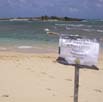 |
| HOME > Field Accounts |
ISLET FIELD ACCOUNTS
Follow the interns and volunteers through their work on the offshore islets. Click on the photos to link to a photo gallery for each visit.
|
|
> 19 Feb 2007: Moku'au'ia (Goat Island), O'ahu
> 29 Feb 2007: Mokulua, O'ahu
> 28 Mar 2007: Kaohikaipu (Black Rock), O'ahu
> 2-3 April 2007: Po'opo'o, Lana'i
> 2-3 April 2007: Pu'u pehe (Sweetheart Rock), Lana'i
> 5 Apr and 7 Apr 2007: Moku'au'ia (Goat Island), O'ahu
> 5-7 Apr 2007: Mokoli'i (Chinaman's Hat), O'ahu
> 29 Apr 2007: Kapapa (Mokukapapa), O'ahu
> 3-4 May 2007: Lehua, Kaua'i and Ni'ihau
> 9 May 2007: Moku'au'ia (Goat Island), O'ahu
> 12 May 2007: Mokoli'i (Chinaman's Hat), O'ahu
> 29-31 May 2007: Molokini, Maui
> 29-31 May 2007: Kaemi, Maui
> 29-31 May 2007: Hulu, Maui
> 1 Jun 2007: Moku'au'ia (Goat Island), O'ahu
> 8 Jun 2007: Moku'au'ia (Goat Island), O'ahu
> 15 Jun 2007: Moku'au'ia (Goat Island), O'ahu
> 22 Jun 2007: Moku'au'ia (Goat Island), O'ahu
> 29 Jun 2007: Moku'au'ia (Goat Island), O'ahu
> 6 Jul 2007: Moku'au'ia (Goat Island), O'ahu
> 18 Jul 2007: Moku'au'ia (Goat Island), O'ahu
> 24 Jul 2007: Moku'au'ia (Goat Island), O'ahu
> 31 Jul 2007: Moku'au'ia (Goat Island), O'ahu
> 7 Aug and 30 Aug 2007: Kapapa (Mokukapapa), O'ahu
> 7 Aug and 30 Aug 2007: Kaohikaipu (Black Rock), O'ahu
> 8 Aug 2007: Moku'au'ia (Goat Island), O'ahu
> 17 Aug 2007: Moku'au'ia (Goat Island), O'ahu
> 17 Aug 2007: Mokoli'i (Chinaman's Hat), O'ahu
> 24 Aug 2007: Moku'au'ia (Goat Island), O'ahu
> 8 Sep 2007: Mokauea, O'ahu
> 10 Sep 2007: Moku'ae'ae, Kaua'i and Ni'ihau
> 18-20 Sep 2007: Mokapu, Moloka'i
> 18-20 Sep 2007: 'Okala, Moloka'i
> 21 Sep 2007: Mokoli'i (Chinaman's Hat), O'ahu
> 22 Sep 2007: Moku'au'ia (Goat Island), O'ahu
> 24 Sep 2007: Kaohikaipu (Black Rock), O'ahu
> 24 Sep 2007: Manana (Rabbit Island), O'ahu
> 14-16 Oct 2007: Mokoli'i (Chinaman's Hat), O'ahu
> 17 Oct 2007: Popo'ia (Flat Island), O'ahu
> 20-21 Oct 2007: Kapapa (Mokukapapa), O'ahu
> 25 Oct 2007: Moke'ehia, Maui
> 26 Oct 2007: Mokupipi, Maui
> 27 Oct 2007: Pu'uku (Pu'uki'i), Maui
> 1 Nov 2007: Po'opo'o, Lana'i
> 1 Nov 2007: Moku mana, Maui
> 2 Nov 2007: Pu'u pehe (Sweetheart Rock), Lana'i
> 2 Nov 2007: Ki'ei, Lana'i
> 10 Nov 2007: Mokauea, O'ahu
> 1-2 Dec 2007: Kaohikaipu (Black Rock), O'ahu
> 9 Feb and Feb 11 2008: Manana (Rabbit Island), O'ahu
> 15 Feb 2008: Mokuho'oniki, Moloka'i
> 16 Feb 2008: Moku manu, Moloka'i
> 16 Feb 2008: Kanaha, Moloka'i
> 19 Mar 2008: 'Alau, Maui
> 20 Mar 2008: Mokuhuki, Maui
> 26 Mar 2008: 'Ale'ale, Kaho'olawe
> 26 Mar 2008: Pu'u koa'e, Kaho'olawe
|
|
Moku'au'ia (Goat Island) 24 Jul 2007
|
|
Trip Goal: To assist DOFAW biologists in an attempt to eradicate Yellow Crazy Ants from the islet using Mokoli'i Islet as a control (no bait used). Using the results of our bait preference trials, a new bait was made specifically for controlling Yellow Crazy Ants in Hawai'i. This ant species has disrupted seabird colonies and ecosystems elsewhere in Hawai'i and around the tropics, but eradication has been troublesome. A successful eradication on Moku'auia would be great step in restoring these fragile island ecosystems to their natural state. Accomplishments: Over the course of 3 months, we completed 2 ant bait applications and conducted intensive monitoring of the ant and seabird populations. We were able to significantly reduce ant numbers, but not eradicate them entirely. However, as a result of our experiment, seabirds were able to survive and successfully hatch chicks on the island. No seabird chicks survived on our control islet (Mokoli'i), where ant bait was not applied. More importantly, we have learned from the project and will readjust the bait amounts and timing and will hopefully eradicate the ants soon.
|

Photo Gallery
|
Intern Account: Malia:
"The travel out to the island on this field day was the most difficult we had ever experienced due to fairly deep water, wind, and waves. When we arrived on the islet, I expected to find the number of ants decreasing, since bait was spread throughout the islet for the second time about two weeks ago. After laying out the ant baits of spam, honey, and peanut butter, we began the transect. I followed closest the northern side of the islet. There seemed to be fewer ants in my area as a whole. In the naupaka (where there are usually a prolific number of ants) there were fewer ants than last time. Each time I found ants, I only found a few at a time. The dry areas remained ant-less and the lush areas showed a significant decrease in the ant population. When examining Plot 1, again there seemed to be fewer ants than before. We were afraid that becuase of the slight increase in population the week before, the ant population would begin to follow that increasing trend. The nest that was found in the beginning of our field work was still demolished. In that area we only found three or four ants. There were sparse patches with few ants throughout the plot, but there were no nests present. While picking up the ant bait, the number of ants seems to be decreasing after the respreading of the poison. There is always one area near the naupaka bushes where there are hundreds upon hundreds of ants present, so we think that a nest may be present under the nearby rock. We noticed no other seabirds killed due to the dog that swims out to the island. But we did notice one seabird's head ripped off and pecked out by what could possibly be an owl. I hope that the ant population continues to dwindle."
|
|
|

